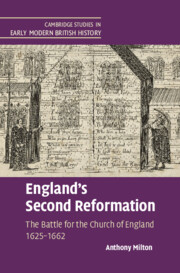Book contents
- England’s Second Reformation
- Cambridge Studies in Early Modern British History
- England’s Second Reformation
- Copyright page
- Dedication
- Contents
- Acknowledgements
- Abbreviations
- Introduction
- Chapter 1 An Unresolved Reformation
- Chapter 2 Situating the Laudian Reformation
- Chapter 3 Responses to the Laudian Reformation
- Chapter 4 The Abortive Reformation, 1640–1642
- Chapter 5 The End of Episcopalian Reformation
- Chapter 6 Reformation by Negotiation
- Chapter 7 The Westminster Reformation and the Parliamentarian Church of England
- Chapter 8 The Royalist Church of England, 1642–1649
- Chapter 9 Alternative Reformations, 1649–1653
- Chapter 10 The Cromwellian Church
- Chapter 11 Episcopalian Royalism in the 1650s
- Chapter 12 Failed Reformations, 1659–1661
- Chapter 13 The End of Comprehensive Reformation and the Caroline Settlement
- Conclusion
- Index
Chapter 1 - An Unresolved Reformation
Published online by Cambridge University Press: 05 October 2021
- England’s Second Reformation
- Cambridge Studies in Early Modern British History
- England’s Second Reformation
- Copyright page
- Dedication
- Contents
- Acknowledgements
- Abbreviations
- Introduction
- Chapter 1 An Unresolved Reformation
- Chapter 2 Situating the Laudian Reformation
- Chapter 3 Responses to the Laudian Reformation
- Chapter 4 The Abortive Reformation, 1640–1642
- Chapter 5 The End of Episcopalian Reformation
- Chapter 6 Reformation by Negotiation
- Chapter 7 The Westminster Reformation and the Parliamentarian Church of England
- Chapter 8 The Royalist Church of England, 1642–1649
- Chapter 9 Alternative Reformations, 1649–1653
- Chapter 10 The Cromwellian Church
- Chapter 11 Episcopalian Royalism in the 1650s
- Chapter 12 Failed Reformations, 1659–1661
- Chapter 13 The End of Comprehensive Reformation and the Caroline Settlement
- Conclusion
- Index
Summary
Challenging the assumption that the Elizabethan religious settlement was clear in its content and meaning to contemporaries, Chapter 1 explores the many areas of confusion and ambiguity surrounding the settlement’s formularies. It emphasizes the contested authority of a range of official and semi-official formularies and commentaries, and of past doctrinal and liturgical forms, which potentially pointed in very different theological and ecclesiastical directions. A number of unresolved issues are highlighted relating to church government, liturgy and ceremonies, doctrine, ministerial maintenance, and ecclesiastical law. As a result, the Church of England’s position was inevitably subject to continual negotiation and debate, and to countless proposals for further reform and clarification. It is argued that, as a result, a very broad range of English religious thinkers and activists – from militant high-churchmen to staunchly Calvinist and incipiently Presbyterian puritans – could in the ensuing years seize on some of these threads and claim with some legitimacy to be accomplishing the final clarification and consummation – and indeed the apotheosis – of the earlier Reformations. The Laudian movement would thus constitute just one contested reading of this haphazard corpus of ambiguous ecclesiastical and doctrinal formulations.
Keywords
- Type
- Chapter
- Information
- England's Second ReformationThe Battle for the Church of England 1625–1662, pp. 12 - 33Publisher: Cambridge University PressPrint publication year: 2021

